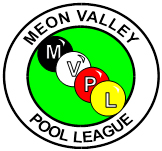Current Playing Rules
Blackball Pool Rules Guide
DEFINITIONS
1. Shot: A shot is a strike on the cue ball with the tip of a cue. A ‘shot’ ends when all balls have come to rest.
2. Play: To ‘play’ an object ball is to strike the cue ball with the tip of the cue and the cue ball then makes contact with an object ball.
3. Ball On: At any time during a frame, a ball ‘on’ is any object ball that the player may play without incurring a penalty.
4. Pot: A ball is ‘potted’ when it leaves the bed of the table, enters a pocket and remains in that pocket.
5. Free shot: A free shot means that, with the first shot after a foul has been committed, a player may play any ball on the table and still be in control of the table, whether the player pots the object ball or not. The player may even play the black ball, but may not pot the black ball unless it is the ball “on”.
6. Turn: A player’s ‘turn’ at the table consists of one visit or, after most fouls committed by an opponent, a free shot plus one visit.
7. Visit: A visit comprises a shot or a series of shots.
8. Frame: A frame is one game of blackball between two players or two pairs of players or two teams of players. A frame begins with the opening break and usually ends when the black ball is potted. (Note: there are other ways that a frame may end – (see Rule 7 ‘loss of frame’ fouls).
9. Match: A match is a predetermined number of frames between two players, two pairs of players or two teams of players e.g. a race to 7 (the player who reaches 7 frames first is declared the winner of the match.
10. Player in Control: A player (and the player’s partner in doubles) is deemed to be ‘in control’ of the frame from the time that the balls stop moving after the final shot of an opponent’s turn until the balls stop moving after the final shot of the player’s turn. There can be no instance, once a frame has commenced, that someone is not in control.
11. Legal Shot: On all shots played the cue ball must make contact with a ball ‘on’ and then either pot the ball ‘on’ or play the cue ball onto an object ball for either of the balls to touch a cushion. When snookered, a player in control of the table only needs to make contact with a ball(s) ‘on’ to execute a legal shot, even without touching a cushion.
12. Playing Surface: The playing surface on a pool table is the flat part of the table between the cushions.
1. BLACKBALL
The Game shall be known as ‘Blackball’ and referred to in these rules as “the game”. It is intended that layers and teams should play Blackball in the true spirit of the game and in a sportsmanlike manner. It should be clearly understood that the referee is the sole judge of what is fair and unfair play. The referee shall take whatever action is necessary to ensure that these rules are observed.
2. EQUIPMENT AND TABLE LAYOUT
The game is played on a six pocket rectangular pool table with six cushions and a set of balls consisting of:
a. A white ball called the “cue ball”.
b. 2 (two) groups of object balls consisting of seven (7) red or blue or solids balls (numbered 1 to 7) and seven (7) yellow or striped balls (numbered 9 to 15).
c. A black ball (8-ball).
d. Spider rest, goose-neck rest and cross rest.
e. Prescribed cue.
f. No other equipment is permitted unless ratified by the WPA.
g. The Pool Table: The playing surface is the bed of the table bordered by cushions. The bed of the table should be marked with a black spot at the intersection of two imaginary diagonal lines joining the centre and corner pockets. The cloth will be marked with a baulk line, being a straight line drawn from cushion to cushion at 1/5th of the length of the table from the face of the cushion which lies the greatest distance from the black spot. The Baulk is the rectangular area bordered by the baulk line and 3 (three) cushions.
3. OBJECT OF THE GAME
The player or team that pockets one group of object balls first, in any order, and then legally pots the black ball wins the game.
4. COMMENCEMENT OF THE GAME
The opening break shot is determined by a lag. The player who wins the lag decides who breaks.
The Lag: The following procedure is used for the lag to determine who breaks first. Players should use balls of equal size and weight, preferably cue balls, but when not available the players may use any two object balls. With the balls in hand behind the baulk line, one player to the left and one to the right of the table, the balls are struck simultaneously to the top cushion to then return to the baulk cushion. The player whose ball is the closest to the edge of the baulk cushion wins the lag. It is an automatic loss of the lag if:
a) The ball crosses into the opponent's half of the table;
b) The ball fails to contact the top cushion;
c) The ball drops into a pocket;
d) The ball jumps off the table;
e) The ball touches the side cushion;
f) The ball rests within the corner pocket and past the nose of the baulk cushion.
If both players violate the “automatic loss” lag rules or if the referee is unable to determine which ball is closer, the lag is a tie and is replayed.
Opening Break Shot: The player winning the lag has the choice of performing the opening break shot or assigning it to the opponent.
Cue Ball on Opening Break: The opening break shot is taken with cue ball in hand behind the baulk line. On the opening break, the game is considered to have commenced once the cue ball has been struck by the cue tip. The same applies to a rerack (after a foul break if the opponent decides to re-rack the balls) or a stalemate. (Refer to 4q).
4(a) The Rack: The balls are racked as illustrated below, with the black ball on the black spot. No mirror image is allowed.
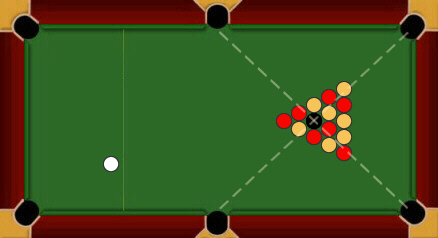
The head ball (the ball closest to the baulk line) should be a red, blue or solid ball.
4(b) The Break: The first shot of a frame is called the ‘break’, which occurs when the cue ball is played at the triangle of object balls from any position within baulk. If the centre of the cue ball is on the baulk line, this is deemed to be in baulk. The frame is deemed to have commenced the instant the player’s cue tip makes contact with the cue ball.
(1) The break will be deemed a legal break if at least one ball is potted OR at least two different object balls pass an imaginary line between the middle of the two centre pockets.
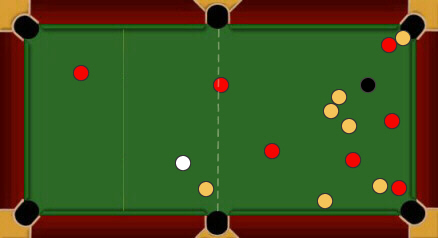
(2) If the break is not a legal break, the opponent is awarded one free shot plus one visit. The player may play the cue ball from where it lies or has the option to play the cue ball from the baulk or the balls may be re-racked if the player so chooses. The player still has a visit after the break shot.
4(c) Playing from Baulk: Baulk is the rectangular area of the table that is bordered by the baulk line and the three cushions at that end of the table.
(a) The centre point of the cue ball must be in baulk when a shot is played - See Rule 4(b).
(b) The cue ball can be moved into position only by hand and not with the shaft of the cue as it is a foul to touch the cue ball with anything other than the tip of the cue. The player may continue to adjust the position of the cue ball by hand until a shot is played.
(c) The cue ball may be played in any direction.
If the player decides to play from baulk, after a foul has been committed by an opponent, the player must position the cue ball in baulk without touching any other ball(s). It is a foul, if during placement, the cue ball touches any other ball.
4(d) Potting the Black Ball on the Break or on a Re-Rack:
If the black ball is potted on any break, including a re-rack break, all the balls are re-racked and the same player breaks again. No penalty will be incurred. This applies even if other balls, including the cue ball, are pocketed or leave the playing surface (off the bed of the table).
4(e) Deciding Groups:
Groups are NOT decided and the table remains open. . .
1. On a break shot.
2. On a foul shot.
3. On a “free” shot after a foul.
4. On a “combination” shot in which balls from both groups are potted.
After the break shot, the table is open and the player in control may play a ball(s) from either group. The black ball cannot be used as a ‘ball on’ to pot any object ball, except after a foul has been committed and the table is open. If the player in control pockets a ball(s) of both groups with the next shot, the table still remains open.

If the player in control pockets a ball(s), even on a combination shot, of a single group, the player is on that group of balls.
Once groups are decided the player remains on that group for the entire duration of the frame. The opponent has to take the other group of balls.
4(f) Deciding Groups after a Foul Shot: If a foul is committed on an open table and one or more object ball(s) are pocketed, then those balls are ignored in determining the groups to be played. The incoming player faces an open table and has a free visit playable from where the cue ball had stopped or from baulk.
4(g) Player in Control: If a ball(s) is legally pocketed, this entitles the player in control to one additional shot. This continues until the player either:
(1) Fails to pocket one of the allocated balls or
(2) Commits a foul.
The player then loses control of the table.
4(h) Cue Ball in Hand: A player, who has the cue ball in hand, may play from any position within baulk and in any direction. Legal placement of cue ball is described in Rule 4(c).
4(i) Touching Balls: Play away from any touching ball.
If the touching ball is a “ball on”. The player is deemed to have played that ball. To play a legal shot, the player need only pot a ball from own group OR cause any ball, including the cue ball, to strike a cushion.
Playing away from a touching object ball ‘not on’
The player must play away from the touching ball and then meet all the requirements of a legal shot.
Playing away from two or more touching object balls
The player in control must play away from all touching balls and then meet all the requirements of a legal shot. However, if the cue ball is touching the player’s ball and the opponent’s ball at the same time, then the player must play away from his/her ball in order to perform a legal shot, without incurring a penalty.
If, at any time, it is not possible to play a legal shot, then the game is a stalemate and the balls must be reracked. Should a touching ball move while “playing away”, then the player in control has committed a foul.
4(j) Combination Shots: Two or more object balls may be potted in a single “skill shot” without a penalty being incurred.
(1) A combination (or skill) shot is achieved when a player plays a legal shot and in the same shot pots an opponent’s ball(s). In such a case it does not matter which ball falls into the pocket first. There is no penalty incurred when a legal combination shot is played.
(2) A combination shot can include the black ball, subject to the ball “on” being the last ball of the player’s colour. In such a case it does not matter which ball falls into the pocket first, as long as a legal shot was executed.
(3) A combination shot can also include playing the black ball (when the black ball is ball ‘on’) onto an opponent’s object ball(s) and potting both balls, without incurring a penalty.
(4) In combination shots after a foul, the player may use a free shot to make initial contact with any ball. For example the player may play an opponent’s ball onto the black ball to pocket the black ball and win the frame, provided the player is “on” the black ball. In this instance it is not necessary to pot the opponent’s ball.
4(k) Balls off the Table: It is a foul if a ball leaves the playing surface, does not return by its own means and remains off the playing surface (other than when potted).
Balls are returned to the table as follows . . . .
(a) If it is the cue ball, it is to be played from baulk.
(b) If it is an object ball(s) it is to be spotted - Refer to rule (4l)
A ball returning to the table “by its own means”. . . .
(a) It is not a foul if a ball leaves the playing surface, runs along the top of a cushion drops back onto the playing surface and comes to rest there or falls into a pocket.
(b) It is a foul if a ball leaves the playing surface, comes into contact with a person or object (e.g. a block of chalk), that is not part of the table. and then returns to the playing surface.
4(l) Re-spotting Balls: If it is the cue ball, it is to be played from baulk.
An object ball is re-spotted with its centre point on the black spot or as near as possible to that spot in a direct line between the spot and the centre point of the cushion which lies furthest from the baulk line.
Object balls are re-spotted in the following order:
(a) Black ball (b) Red or Blue or solid balls (1-7). (c) Yellow or Striped balls (9-15). Spotted balls should be placed as close as possible to each other and any intervening balls, without touching each other.
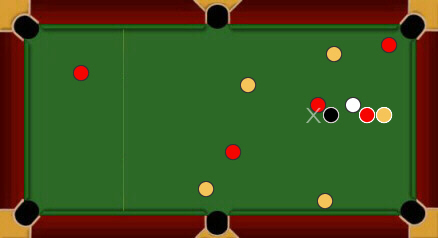
4(m) Interference: There is NO penalty incurred if balls are moved under the following circumstances:
(a) By a person other than the players taking part in the frame, or
(b) As a direct result of one of the players being bumped, or
(c) Due to events deemed outside the player’s control.
The referee will return the balls as closely as possible to their original positions. (The referee’s decision on placement of the ball(s) is final).
A player may not use chalk or other objects as a marker for a shot. It is not a foul to place chalk on the table while in control but it should be removed before an opponent addresses the table. Intentional marking, such as positioning chalk to aid in a shot, is a foul.
4(n) Ball falling in without being struck: Ball on edge of pocket:
(a) If a ball falls into a pocket without being struck by another ball, after being motionless for five seconds or longer, and being no part of any stroke in progress, it shall be replaced and play shall continue.
(b) If a ball falls into a pocket ‘by itself’ during a shot, so that it would have been hit by another ball had that ball still been there, all balls are to be replaced to their positions prior to the stroke. The player may replay the shot or choose a different shot.
(c) If a ball balances momentarily on the edge of a pocket and then falls in; it shall count as in the pocket and not be replaced.
4(o) Object Ball Frozen to a Cushion: When the cue ball makes first contact with an “on” object ball which is “frozen” to a cushion, it is a foul if
the shot does not result in. . . .
a. A ball being potted OR
b. The cue ball contacting a cushion OR
c. The frozen ball contacting a cushion attached to a “separate” rail OR
d. Any other object ball contacting a cushion with which it was not already in contact before the shot was played.
e. A ball touching a cushion at the start of a shot which is forced into the same cushion is not considered to have struck that cushion unless it leaves the cushion, strikes another ball, and then contacts the cushion again.
An object ball is not considered frozen to a cushion unless this is announced by a referee or a player prior to a shot being played.
4(p) Snookers: A player is considered snookered when it is impossible to hit any part of any ball ‘on’ by way of a straight line shot. In this situation the player need only cause the cue ball to contact a ball ‘on’ to execute a legal shot. The player does not have to pot a ball or cause the cue ball or another ball to touch a cushion to execute a legal shot.
4(q) Stalemate: Should any situation arise whereby a legal shot cannot be played, whether this situation is arrived at by accident or design, the frame shall be restarted.
If the re-rack is due to stalemate by accident the same player will break again. If the re-rack is due to slow or negative play or by design, the players will re-lag to determine who will break. Re-racks may involve a reduced number of balls - See 8(g).
4(r) Completion of a Frame or Game: The frame or game is completed when the black ball is potted during a legal shot and all the remaining balls including the cue ball have come to rest or there is a loss of frame situation. If the player plays a further shot or interferes with the remaining balls while the balls are still moving, then this is a loss of frame.
5. FOULS
Fouls are to be called by the referee as soon as they occur and the player, who had committed the foul, immediately loses control of the table. The referee then awards a free shot plus one visit to opponent. Under serious circumstances, the referee awards a loss of frame.
5(a) Potting the cue ball - ‘in-off’ (also from the break). Following an “in-off”, the cue ball may be retrieved from the basket by a referee or by a player (in the absence of a referee).
5(b) Playing from outside baulk when obliged to play from baulk.
5(c) Potting an opponent’s ball without potting a ball from your own group.
5(d) Failing to perform a legal shot.
5(e) Playing a jump shot, which causes the cue ball to leave the surface of the table and jump over any ball, is a foul. However, if the cue ball jumps over a ball after a legal shot has been executed, then this will not be considered a foul shot.
5(f) Playing a push stroke, which is defined as when the tip of the cue remains in contact with the cue ball once it has commenced its forward motion, is a foul.
5(g) Not playing a legal shot after being snookered.
5(h) Striking the cue ball with any part of the cue other than the tip.
5(i) Playing a shot before all balls have come to rest from the previous shot.
5(j) Playing a shot before all balls that require spotting, have been spotted.
5(k) Playing out of turn.
5(l) Playing a double hit which causes the cue tip to contact the cue ball more than once in the same shot.
5(m) Playing a shot without having at least one foot touching the floor. A player must have at least one foot on the floor, except where special needs apply (i.e. physical disability or other special needs).
5(n) A player’s body or part thereof, clothing, jewellery, or any accessory or part of a cue touching any ball. A player is responsible for any equipment brought to the table, other than those supplied by the tournament. Should the end fall off a rest or spider, that has been supplied, and make contact with a ball on the table, this will not be a foul as the player should not suffer any penalty because of faulty equipment. Should it be the player’s own equipment (chalk, cue tip etc.), it will be a foul and normal rules will apply.
6. PENALTY AFTER A FOWL
6(a) Loss of control of table: After any foul, the offending player loses the next visit to the table, and the opponent is entitled to a free shot plus one visit.
6(b) Free Shot: On the free shot, the oncoming player may, without nomination, play the cue ball onto any ball(s) without penalty.
6(c) Cue ball option: Following any foul, the player in control has the option of playing the cue ball from where it lies on the bed of the table or moving it to baulk. Moving the cue ball does not constitute a shot or a visit.
7. LOSS OF FRAME FOULS:
7(a) Committing a foul in the same shot that the black ball is potted.
7(b) Potting the black ball when a ball(s) of the player’s own group are still on the table.
7(c) Committing a deliberate foul. A player who clearly and intentionally plays a ball not ‘on’ will have committed a deliberate foul resulting in loss of frame. A player who clearly and intentionally fails to make an attempt to play a ball(s) of his/her own group will lose the frame.
A player who clearly fails to attempt to play an 'on' ball OR deliberately plays a ball which is 'not on' will lose the frame. The player's group is red in this image. Only the black remains to be potted, but the player is snookered. There is a possible shot, up and down the table, to escape the snooker. If in playing up and down the player is considered to have made little attempt to make the shot (for example by leaving the cue ball well short) there is a risk of losing the frame for playing a deliberate foul. The decision is with the referee.
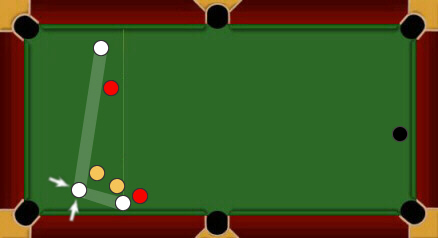
Here the player 'on' yellows intentionally plays a yellow ball onto a red which is potted. The player was NOT on a free' shot. In striking a ball from his own group first the player has fulfilled the requirements of a legal shot described above. It is however a standard foul for potting an opponent's ball, but it is not loss of frame. This may be regarded as a tactical option.
7(d) A referee is the only person who can deliberately touch any ball on the bed of the table, including the cue ball, after a foul. In the absence of a referee, a player must inform the opponent of his/her intention to pick up the cue ball. If a player picks up any ball without informing the opponent, then the player will lose the frame.
7(e) If the cue ball is in the process of going “in-off” and the opponent catches the cue ball, preventing it from going into the pocket and through the table mechanism, then it is a LOSS OF FRAME.
7(f) Deliberately interfering, by word or action, so as to disrupt an opponent’s play.
8. GENERAL TOURNAMENT AND LEAGUE GUIDELINES
(Playing with a referee)
8(a) Time Foul: A player has a maximum of 60 seconds to play each shot, including the break and “ball in hand”. The referee will start timing when all balls have come to rest from the previous shot. If a player has not played a shot within 60 seconds, it is a foul and the opposing player will be awarded a free shot plus one visit. If the first 30 seconds lapse before a player plays a shot, the referee will announce: “30 seconds” as a warning to the player. The call must be made the instant the 30 seconds has expired. The referee should not postpone the call because it appears that the player is about to play a shot, even if it means speaking while a player is addressing the table.
Following an “in-off”, the player or referee may recover the cue ball from the basket. If the player takes time to recover the cue ball, the referee will recover the cue ball and hand it to the player who is in control of the table. As soon as the cue ball is handed to the player, or the player recovers the cue ball, the referee will start timing and the player has a maximum of 60 seconds to play the next shot
.
A “Time Out” may be called for the following reasons:
1. A player requests a rest/bridge.
2. Something is obstructing the player.
3. A “touching ball” decision.
4. A “snooker” decision.
The referee must use his/her discretion and this call must be made loud enough so that both players can hear the call.
8(b) Unsportsmanlike conduct: If the player breaches the “Spirit of the Game” to such an extent that the frame (or match) should be awarded to the opponent.
Guidelines on Unsportsmanlike Conduct
1. The use of foul language or swearing.
2. Player throwing his/her cue around or unscrewing it as if to concede.
3. Arguing with an opponent, spectator or referee.
4. Continuously disagreeing with the referee’s decision and/or ruling.
5. Interfering while the opponent is playing a shot.
6. A player not moving away from the table and out of the opponent’s way, at the end of his/her visit, will be considered unsportsmanlike behaviour.
8(c) Coaching: During a frame, a player is required to play without receiving any advice from other persons relating to the playing of the frame. If, in the opinion of the referee, the outcome of the frame has been compromised, the referee may decide to award the frame to the opponent. The referee should in all cases see that the game is played in a fair and just manner.
8(d) Leaving the playing area: If a player needs to leave the playing area during a match, the player must have the referee’s permission. A player may not leave the playing area during a frame unless exceptional circumstances apply, and the tournament director has been advised before the match begins. If the match isn’t refereed, players should only take necessary bathroom breaks between frames.
8(e) Rule Clarification by Referee: A referee may, if requested, advise on the rules of the game. When asked for a clarification of a rule, the referee will explain the applicable rule to the best of his/her ability. The referee must not offer or provide any subjective opinion that would affect play, such as whether a legal shot can be played on a prospective shot. The referee will not be held responsible for incorrect information as it is the players’ duty to know the rules of the game.
8(f) Time Wastage: The referee should ensure that excessive time is not taken to play a shot and should act in accordance with competition rules or guidance. This is required for an event does not use the time rule as per rule 8(a).
8(g) 9 Ball Re-Racks: In the event of slow or negative play, the balls are re-racked using only 9 balls. Rack the 15 balls and then remove the first ball and the last row of five balls. The players must also re-lag to determine who will break in this situation.
8(h) Doubles Matches: In doubles matches, the regular Blackball Rules apply. Communication between partners is permitted prior to their visit to the table. Once a player has approached the table, conversation with others, including his/her partner is not permitted. Only after a team has lost control of the table will the partners be able to communicate with each other.
The only exception to this rule is that, after a break or re-break, the partners are permitted to discuss their options and shots. However, as soon as one partner has begun addressing the table, all communication will cease until the team has lost control of the table. This applies for the entire duration of the frame/match.
8(i) Playing without a referee: When a referee is not available, any dispute between two players should be immediately referred to the Tournament Director or an appointed substitute. Play must stop to allow an official to be called as any protest must be made immediately and prior to any subsequent shot being taken, or it cannot be considered or honoured. If the player fails to do so, the foul is considered not to have occurred.
All players must honour an opponent’s request and play must be halted, if an official is to be summoned or if a referee is to check or verify a rule question with other officials. Failure to honour such requests may result in disqualification or forfeiture of the game or match under the provisions of “Unsportsmanlike Conduct”.
